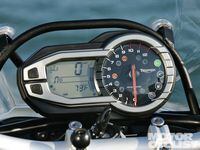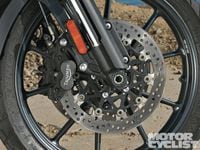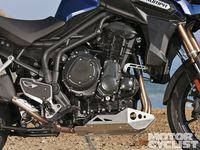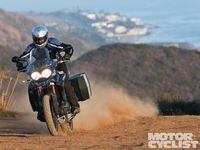They say: "A whole new level of ADV performance."
We say: "A Gold Wing in BMW GS clothing."
Form does not always predict function. With your Standard Expectation goggles in place, you’d never think a Honda Gold Wing could well and truly hustle down a twisty road or that a BMW K1600GT can accelerate hard enough to take your breath away. View the Triumph Tiger Explorer through those same lenses and you might be fooled into thinking the new model was a much more serious shift toward dirt-readiness for the Tiger lineup. At least compared with the Tiger 1050 or the non-XC version of the Tiger 800—it just looks so butch.
You would be wrong. Above all, the Explorer is a fantastic, world-class touring machine. That’s right, the motorcycle with such overt Paris-to-Dakar intentions might well be the best machine for the Perth-to-Sydney trek on two lanes, the perfect friend for a Portland-to-Portland jaunt with significant stretches of highway thrown in.
In the grand BMW R1200GS tradition, the Explorer does much more than you expect it to, and somewhat less than you figure it could, at least off road. Let’s get this out of the way: The Explorer will not throw itself down at the sight of a dirt road, but several factors indicate it’s not a KTM 990 Adventure competitor—cast wheels, a 19-inch front, Metzeler Tourance EXP rubber, and a wet weight of 588 pounds. It’ll handle graded trails fine, but the low pegs, dangly under bits, and unpredictable reactions of the front tire over washboard surfaces all gently suggest you ask Mr. Garmin for at least a partially paved way back. That the ABS- and TC-cancel functions are so buried in the combo gauge’s menu system offers a subtle hint from Triumph as well.
Point the Explorer at a road, any road with pavement, and suddenly all is right with the world. “Triumph is making a habit of building bikes that are instantly familiar. By the time I’d ridden a tenth of a mile, I knew everything I needed to know about the Explorer,” says our small-bike maven, Ari Henning. “It’s big, yet incredibly well-balanced and surprisingly nimble.” He’s right there. Even though the Explorer’s wheelbase spans 60.2 inches (0.9 in. more than the R-GS’s) and has more trail, it has steeper steering geometry than the BMW and an almost ridiculously wide handlebar. The result: Very low steering forces and fairly quick responses for such a large bike. There is a definite limit to how fast the Explorer will change lean angle, but the overall impressions are of a bike willing to take whatever line you choose, and to do so without complaint. Front-end feel is very good, and steering remains neutral right until you start dinging the footpegs; indeed, the bike feels as though it could be ridden a lot harder if it had more cornering clearance.
Similar praise goes out for the big Tiger’s brakes, a set of Nissin four-piston calipers chomping on 305mm discs up front and a two-piston, sliding-pin caliper chewing on a 282mm disc out back. The un-linked brakes have plenty of feel with quick-acting ABS to keep you upright. As expected, the ABS is too granny-like on gravel—the standard TC settings are also very conservative. While the Kayaba suspension strokes through about 7.5 inches, it’s well controlled: Spring rates are a good compromise between bump absorption and chassis control, while the damping rates are just right. Budget generously for tires: The Explorer’s strong binders and light steering encourage you to brake deep into corners. The poor 110/80 Tourance showed artifacts of our entertainment after 1000 miles. For that matter, it looks like the Explorer will start to square off the rear in 3500 miles or less; that’s a lot of bike for a 150-section tire.
Hard braking is usually the result of accelerating like a fool between corners—and so the Explorer is guilty as charged. The 1215cc triple is one of the finest engines available today—something we declare fully aware of hyperbole echoing off the walls. Smooth, characteristically growly, and really well mannered; these descriptions just start to do the Explorer’s three-cylinder mill justice. While power peaks at a fairly modest 114.3 horsepower at 9100 rpm on our SuperFlow dyno, the torque curve dominates the conversation. Except for a slight dip at 2900 rpm, the four-valve-per-cylinder triple puts down more than 70 lb.-ft. of torque all the way from 2400 to 8600 rpm. And it feels just as good on the road—an endless supply of thrust and strong acceleration in any gear, even the tallish sixth. It’s not peel-your-skin-back power, but it always seems to be just more than you need.
Clicked up into the top cog, the Explorer’s mill settles down into a distant whine, a mere trace of high-frequency vibration sneaking past the counterbalancer and seeking a way out through the bar ends. Plant the Explorer on 80 mph, click on the generally good cruise control, and enjoy being transported through the world. That high seating position gives you a wonderful view, and the open ergonomics keep all those creaky joints in the pain-free zone. (We would like a narrower bar, if only for the inevitable miles in traffic.) Click the multifunction display over to the “miles remaining” screen and count down toward the far horizon. We averaged 41 mpg overall with a consistent 44 mpg on the highway, giving 180-plus miles before reserve.
Thanks to very good weather protection—for this category of bike, anyway—the Explorer is a treat for all day. It doesn’t look like your lower body has much coverage, but the tank bulges help keep the wind from your legs, at least at the knee and above. The combination of headlight/fairing/windscreen does a good job of directing the atmosphere around your torso. With the stock screen, a 5-foot-9 rider resides in relatively smooth air; the screen is adjustable for rake, so taller pilots should be fine as well. The ergonomic picture would be just about perfect with a slightly firmer saddle—as is, the soft seat foam packs down at the end of the day, though the shape invites several seating positions to help alleviate monkey butt.
Triumph has a catalog full of accessories for the Explorer, most of which we’ve seen—and they seem to be good quality—but we tested three on our blue bomber: the $799.99 saddlebags, the $219.99 aluminum belly pan, and the $229.99 heated grips. Warm hands are worth any amount of money, so that’s a must-have. With 62 liters of capacity, the removable hard bags carry a decent amount but, like other Triumph systems, wiggle-waggle conspicuously; the slop clanks the passenger’s right-hand footpeg bracket over bumpy roads. And the pipe eats most of the right-side bag. Give the aftermarket time to spool up some really neat boxes. We’d also opt for the TPMS (tire pressure monitoring system), a steal at $169.99.
At $15,699, the Explorer splits the cheaper Yamaha Super Tenere and the slightly more expensive, outgoing BMW R1200GS (no prices yet for the new model), while undercutting the base Multistrada by $1300. It’s true that the Explorer lacks the visceral performance of the Ducati, and that it’s probably less adept off road than the BMW or the Yamaha. But with its superlative three-cylinder engine, high comfort factor, and smooth suspension, the Explorer has found a home on the open road. It may not look like a long-distance runner, but it surely is.
Tech Spec
















/cloudfront-us-east-1.images.arcpublishing.com/octane/QCZEPHQAMRHZPLHTDJBIJVWL3M.jpg)
/cloudfront-us-east-1.images.arcpublishing.com/octane/HXOUJXQWA5HBHGRO3EMJIGFMVI.jpg)

/cloudfront-us-east-1.images.arcpublishing.com/octane/3TIWWRV4JBBOLDVGRYECVVTA7Y.jpg)
/cloudfront-us-east-1.images.arcpublishing.com/octane/KIX5O23D5NAIBGFXBN3327DKZU.jpg)
/cloudfront-us-east-1.images.arcpublishing.com/octane/7GJYDUIPXRGMTMQKN6ONYOLBOU.jpg)
/cloudfront-us-east-1.images.arcpublishing.com/octane/MUQLOVLL2ZDGFH25ILABNBXKTI.jpg)
/cloudfront-us-east-1.images.arcpublishing.com/octane/TNOU5DNE2BC57MFPMGN2EIDXAM.jpg)
/cloudfront-us-east-1.images.arcpublishing.com/octane/GTCXACQGJ5HAPDTGWUQKDEH44E.jpg)
/cloudfront-us-east-1.images.arcpublishing.com/octane/S35YGSEMEZB4BLTDJTSZPF4GLA.jpg)
/cloudfront-us-east-1.images.arcpublishing.com/octane/5UOT6HPX2JFMRJAX6EH45AR4MQ.jpg)
/cloudfront-us-east-1.images.arcpublishing.com/octane/OKWOJWAKP5EP3OACCRRWPCIX2Q.jpg)
/cloudfront-us-east-1.images.arcpublishing.com/octane/2WF3SCE3NFBQXLDNJM7KMXA45E.jpg)
/cloudfront-us-east-1.images.arcpublishing.com/octane/G4MG6OUCJNBSHIS2MVVOTPX65E.jpg)
/cloudfront-us-east-1.images.arcpublishing.com/octane/IIGGWFOTOJGB7DB6DGBXCCMTDY.jpg)
/cloudfront-us-east-1.images.arcpublishing.com/octane/QSTCM6AVEZA5JJBUXNIQ3DSOF4.jpg)
/cloudfront-us-east-1.images.arcpublishing.com/octane/U4I7G625B5DMLF2DVIJDFZVV6M.jpg)
/cloudfront-us-east-1.images.arcpublishing.com/octane/B6XD6LS6IVCQPIU6HXDJSM3FHY.jpg)
/cloudfront-us-east-1.images.arcpublishing.com/octane/ICL63FEDDRDTTMINYICCEYGMDA.jpg)
/cloudfront-us-east-1.images.arcpublishing.com/octane/FCGZHQXRBZFLBAPC5SDIQLVF4I.jpg)
/cloudfront-us-east-1.images.arcpublishing.com/octane/WNOB6LDOIFFHJKPSVIWDYUGOPM.jpg)

/cloudfront-us-east-1.images.arcpublishing.com/octane/X33NU3E525ECRHXLNUJN2FTRKI.jpg)
/cloudfront-us-east-1.images.arcpublishing.com/octane/6KKT5NNL2JAVBOXMZYS5ZO76YA.jpg)